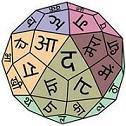Today we’re going to refresh ourselves and have a short ‘whistle-stop’ tour to some of the uses of को ko that we’ve already seen. We’re also going to learn a few new things about it! Are you ready to get going?
The most obvious use of को ko is ‘to’ when giving something to someone, just as we use it in English! For example we might say…

मैं माँ को कपड़ा देता हूँ main maan ko kapraa detaa hoon
- I give the cloth to Mother (Said by a Male)
Can you see here we’ve used माँ को maan ko to mean ‘to Mother’ - because that’s who we are giving it to! See it’s easy, don’t you think? This same use comes up in a bunch of other places though, which to begin with often seems unrelated!
In Hindi when we want to say ‘I like something’ we literally say ‘To me that thing is liked’. So we have to use को ko!

मुझको अनानास पसंद है mujhko anaanaas pasand hai
- I like Pineapple.
Can you see that we literally say ‘to me (मुझको mujhko) Pinapple is liked’. Let’s see another example…

क्या आपको हिन्दी पसंद है? kyaa aapko hindee pasand hai
- Do you like Hindi?
Remeber that क्या kyaa at the start of a sentence turns it into a question! In this sentence we’re literally saying ‘Is to you Hindi liked?’
In Imperatives को ko has a slight different meaning. Using it gives a specificness to an object. So what does this even mean? Well let’s see an example; have a look at the two following sentences…

पानी पियो paanee piyo - Drink water
पानी को पियो paanee ko piyo - Drink the water
So what’s the difference between these two sentences? Well it’s easier than you think, when we use को ko it means we are talking about some specific water and not just water in general! In the first sentence above it’s like we’re reminding someone to keep drinking water all through the day, but in the second we’re telling someone to drink the water right in front of them!
Ready for something new? When we add को ko to Pronouns some of them can change a little. Let me show you how they change first and then I’ll show you a few examples.
I’d take a bit of a deep breath first…
मुझ mujh - ‘Me’ plus को ko - ‘To’ becomes मुझे mujhe - ‘To Me’
हम ham - ‘Us’ plus को ko - ‘To’ becomes हमें hamen - ‘To Us’
तुझ tujh - ‘You’ plus को ko - ‘To’ becomes तुझे tujhe - ‘To You’ (Intimate)
आप aap - ‘You’ plus को ko - ‘To’ is always आपको aapko - ‘To You’ (Formal)
तुम tum - ’You’ plus को ko - ‘To’ becomes तुम्हें tumhen - ‘To me’ (Informal)
इस is - ‘Him / Her’ plus को ko - ‘To’ becomes इसे ise - ‘To Him / Her’ (Close)
उस us - ‘Him / Her’ plus को ko - ‘To’ becomes उसे use - ‘To Him / Her’ (Far)
इन in - ‘Them’ plus को ko - ‘To’ becomes इन्हें inhen - ‘To Them’ (Close)
उन un - ‘Them’ plus को ko - ‘To’ becomes उन्हें unhen - ‘To Them’ (Far)
Phew! So what does this all mean then? Well, for example, whenever you want to say ‘to me’ you can either say मुझको mujhko or मुझे mujhe. Both are perfectly correct but the second is a lot more common in colloquial Hindi! They are completely interchangeable.
So returning to one of our sentences earlier we could say…

मुझे अनानास पसंद है mujhe anaanaas pasand hai
- I like Pineapple.
We’ve simply changed मुझको mujhko to मुझे mujhe - they both mean exactly the same thing! Or, to show you another example we might say…

उन्हें ताला दो unhen taalaa do - Give them the lock
Here we’re simply using उन्हें unhen to mean ‘To Them’ as we learnt above! We could just as well say उनको unko - ‘to them’, both the words mean exactly the same thing.
Phew, we’ll leave it there for today. को ko has so many more uses, it would be impossible to cover them all at once! We’ll see most of them eventually so don’t worry! Today has just been basically a round of up all the places we’ve seen the before, I hope it’s been useful. Please feel free to leave a comment below if you have any questions at all, I’m always here to help
No comments:
Post a Comment